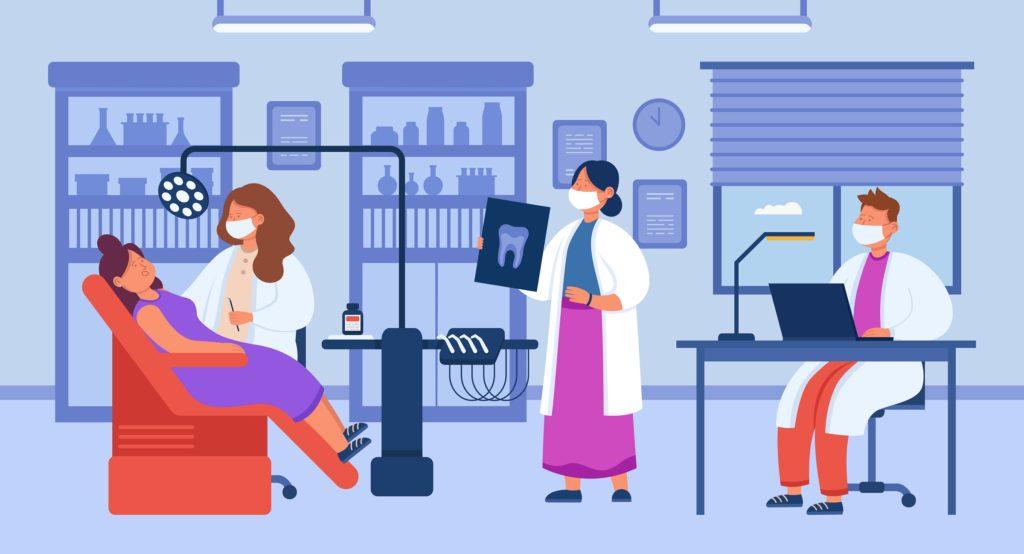
The Role Of Virtual Reality Technology In Training Dental Professionals
What is Virtual Reality Technology?
Virtual Reality (VR) is a computer-generated environment where scenes and objects appear to be real, making the user feel that they are immersed in their surroundings. This environment is perceived through a tool referred to as a Virtual Reality headset or helmet. VR refers to a nonconventional computer graphics system having a virtual sense of reality or surrounding in which display technologies are developed in such a way that the human mind perceives it as an absolute reality depending on the methods used which bring humans to some other place.
VR uses a computer-generated simulation of a 3D environment during which humans can interact with the assistance of specially designed electrical instruments such as gloves, helmets, treadmills, hand/body trackers, and external sensors. It’s an immersive and multisensory participative synthetic environment during which the user acts as an external observer which can improve the quality of life in an uncomfortable and hazardous situation and even in medical fields.
VRT in dentistry
Dental students have to master a lot of visual, practical, and technical skills, along with the theoretical knowledge essential to the dentistry profession. They include a visual assessment of the medical condition, where the three-dimensional (3D) view differs from the photographs from manuals, first-rate psychomotor skills, and an understanding of the technical issues that arise in practice. Off late, in both national and international spheres, the invasive treatments made by the pupil on patients were limited and are being replaced by various alternative training solutions.
On that note, different digital imaging technologies are becoming common in the field of medicine. Virtual Reality (VR) is undoubtedly one of the essential technologies which can be used gainfully in dentistry to cater to challenges innovatively. It helps create a simulated environment with the help of computer technology. In dentistry, this technology is applied to teach new dentists to keep their skills up to date. VR uses smart glasses to provide visual instruction to the dentist to perform the required task. It displays a three-dimensional (3D) model of teeth/whole heads. Trainee dentists can learn and practice different dental techniques. This technology is beneficial to identify new diseases without any hurt to the patient.
This 3D imaging technique also enables them to seek the anatomy of the mouth and teeth. It first familiarizes the doctor with the patient’s teeth anatomy before implantation within the mouth. Thus, it seems an accurate technique used for the teaching and learning of dental professionals and students. Traditionally, a new dentist can feel pressure during the drill. Now using VR technology, the dentist can gain much experience and be happy while performing a particular procedure. This technology enables better communication between the dentist and the patients, which improves patient satisfaction and treatment effectiveness. VR allows a doctor to treat patients from rural areas and at different locations. This technology creates an extremely realistic simulation for the dental patient. It exposes new avenues for therapies for the latest patients. It’s helpful for research and development purposes, which is beneficial to perform new procedures.
VR also helps dental patients with the alignment of human teeth and helps treat cavities and other issues. It creates a highly detailed virtual model of the human body, which can further be used for better treatment and surgery. The learner can zoom through the patient’s mouth using VR. This technology is more flexible for learning than normal two-dimensional images. It has a high clinical impact on dentistry to see tooth anatomy. It allows learners to rotate the tooth image, which visualizes the underlying structure. Dental students and teachers can gain accurate knowledge and examine the training process through VR. With the help of this technology, patient-customized teeth can be captured and sent to the manufacturer for replacement.
As VR enables training using 3D models to seek out the mouth and teeth anatomy of the patient, it provides ideas about drilling during a tooth employing a virtual drill. Atzori et al. experimented by applying VR to five pediatric dental patients between 13 and 20 years old using this technology. After a week of controlled treatment, it was observed that satisfactory results were obtained. It showed significantly lower pain with no side effects. Therefore, this technology was preferred for pediatric patients.
Conclusion
Virtual Reality Technology helps enhance the clinical practice process and dentistry education. Thus, it seems to possess extensive application for planning, training, treatments, and pain management in dentistry. It continually provides different benefits like improving skills, coordination, and training. This technology paves way for an innovative path for research and development in dentistry. Adopting this technology provides a better experience and it proves to be an essential part of modern education. It provides an accurate projection of a radiographic image during a virtual environment sort of a real-world situation. Thus, it’s extensive application in education, clinical treatment, and development. It creates a secure environment to scale back the risk during surgery. Although developing high-quality and precise dental treatment techniques could also be a fundamental part of dental care provision and dental training, communication and empathy also play an important role in the success of patient care. The foremost limitation is the cost and people do not seem much aware of this technology.